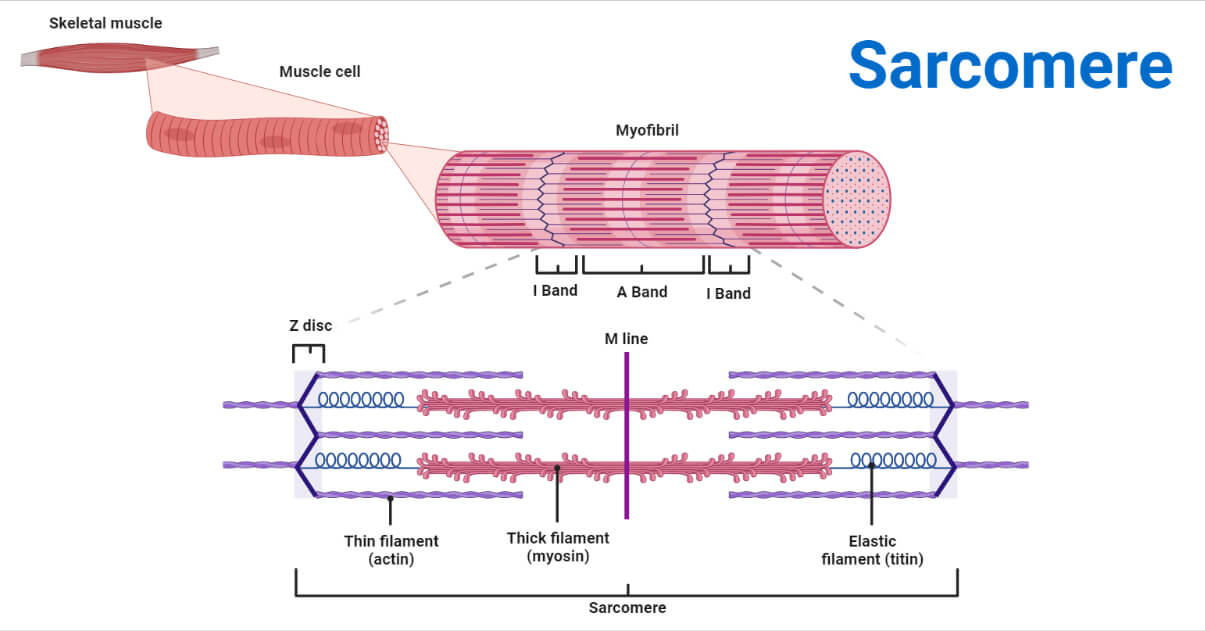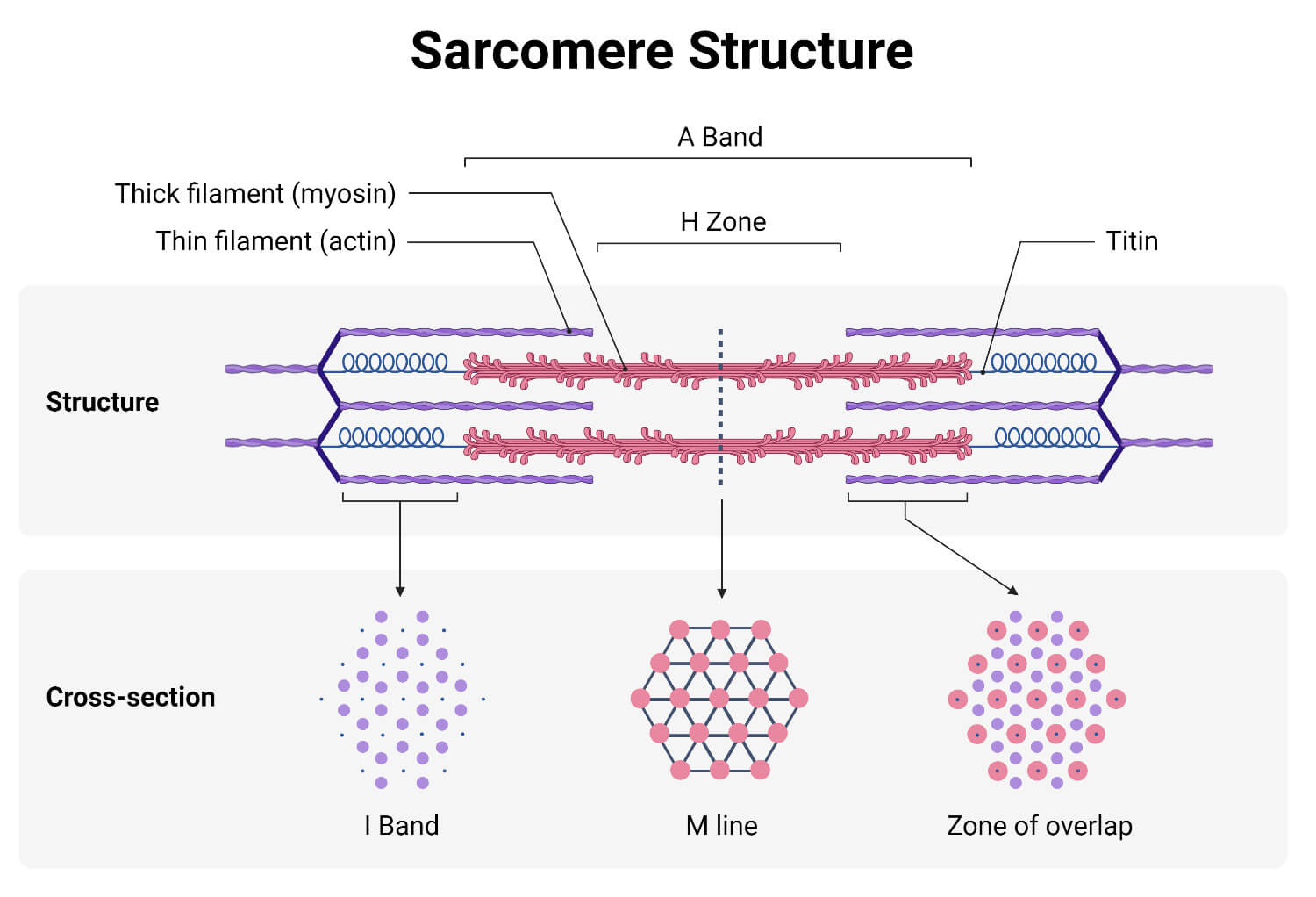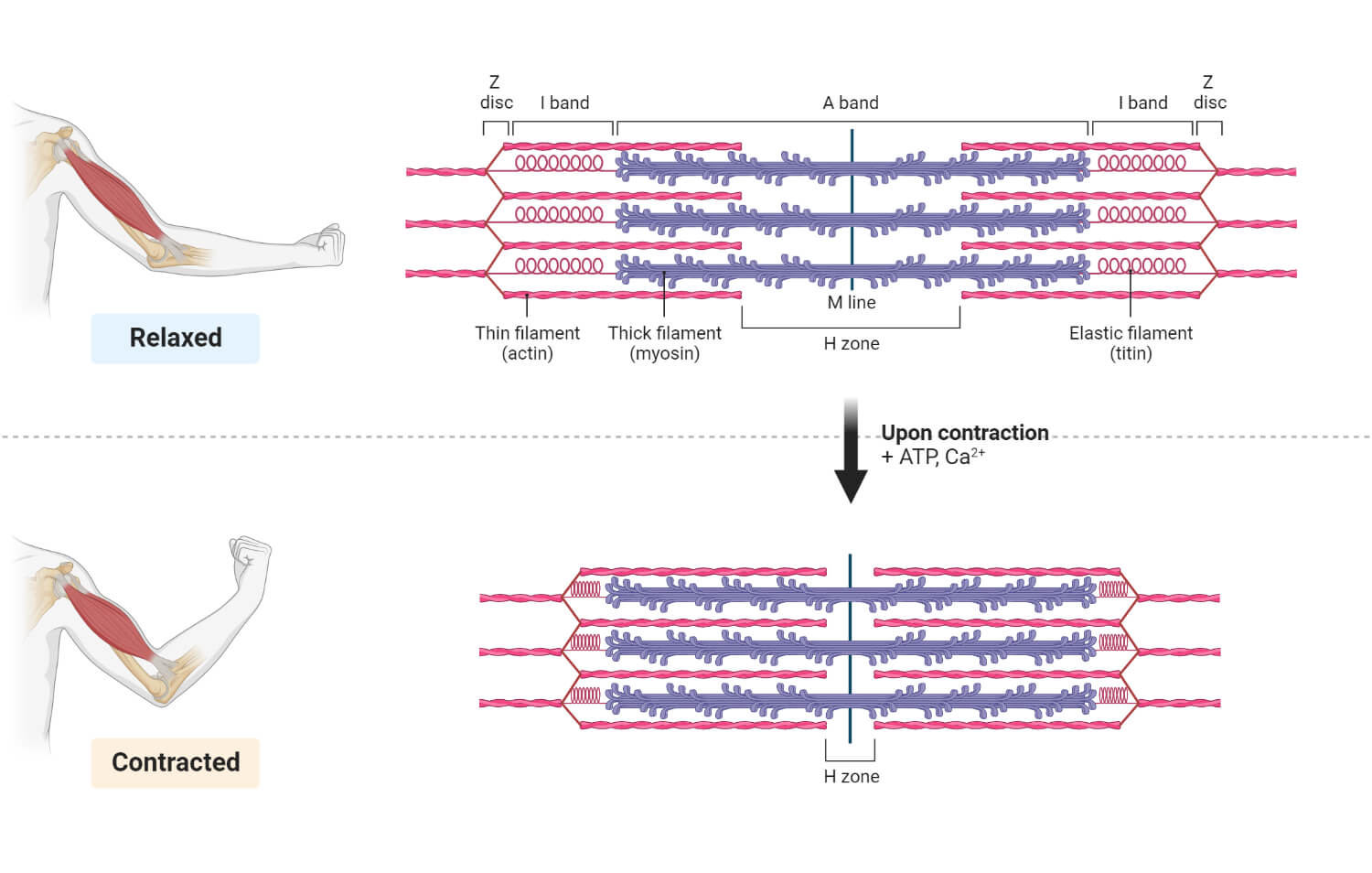Sarcomeres are the basic contractile units of striated muscle cells. A sarcomere is a highly organized structure made up of thick and thin protein filaments; mainly of actin and myosin proteins.
The thick filament is composed of the myosin protein, whereas, the thin filament is made up of the actin protein. Besides these two proteins, other proteins like troponin and tropomyosin are also present in a sarcomere.

The sarcomeres are responsible for the contraction and relaxation of muscle fibers enabling our body to perform mechanical work. The coordinated performance of actin and myosin proteins is responsible for the function of sarcomere.
Structurally, we can see the thick filaments are arranged in a central position with the thin filaments extending from either side of the thick filaments, within a sarcomere. The thin filaments are anchored to a structure called the Z-disc. Myosin filaments (thick filaments) are also connected to the Z-disc through elastic titin molecules filament. The Z-disc defines the boundaries of the sarcomere i.e. a region between two consecutive Z-discs is one sarcomere.
The function of a sarcomere is regulated by a complex system involving the troponin and tropomyosin proteins of the thin filaments. These proteins prevent the binding of actin and myosin filament, preventing the formation of cross-bridge, until a signal for muscle contraction and energy via ATP hydrolysis is obtained.
Interesting Science Videos
Structure of Sarcomere
Sarcomere is a highly organized structure composed of a series of thick and thin protein filaments. These overlapping protein filaments within the sarcomere give the skeletal and cardiac muscles their characteristic striated appearance.
Thick Filaments
The thick filaments, also known as the myosin filaments, are mainly composed of the myosin protein. They are bipolar in nature and are connected to the elastic titin filament which then connects to Z-disc. The thick filaments are arranged in a hexagonal lattice in the center of the sarcomere, in the middle of the two thin filaments. Within a thick filament, several myosin heads are projected outwards, which bind to the thin filament (actin molecules) during muscle contraction. Each thick filament is centrally crosslinked with M-line within A-band.

Thin Filaments
The thin filaments, also known as the actin filaments, are composed of actin protein (as the major component), troponin, and tropomyosin proteins. The troponin and tropomyosin proteins regulate the interaction of thick and thick filaments; hence regulating the muscle contraction process. Thin filaments run along the length of the thick filament, enclosing the thick filament from both sides. The thin filaments are in direct contact with the Z-discs at either end of the sarcomere. Their major parts are present in the I-band and extend up to A-band, but are not found in M-line.
Bands in Sarcomere
Within a sarcomere, there are two distinct bands, A-band and I-band, formed due to the arrangement of thick and thin filaments.
- I-band (Isotropic Band)
I-band is the region of thin filaments that are not superimposed with the myosin (thick) filaments. As in this region, only actin filaments are present, these regions appear lighter under microscopic observation. Hence, I-band is also called the ‘light band’.
- A-band (Anisotropic Band)
A-band is the region of the sarcomere containing thick filaments. This region contains both thick and thin filaments and appears darker under a microscope. Hence, A-band is also called the ‘dark band’.
- H-zone
Within an A-band, there is a region containing thick filament only, called the H-zone.
- M-line
Within the H-zone, in the center of a sarcomere, there is a strip of myomesin protein, called the M-line. M-line interconnects the thick filaments of a sarcomere.
- Z-disc
Z-disc is a protein structure that forms the outer border of a sarcomere. The Z-disc appears as a thin dark line in the center of the two I-bands of two consecutive sarcomeres. Z-disc is made of hundreds of proteins including actinin and titin proteins. The thin filaments are anchored to the Z-disc via alpha-actinin protein. Similarly, a long filament of titin protein is also attached to the Z-disc which a thick filament is attached.

Functions of Sarcomere
Sarcomere is the basic contractile unit of striated muscle containing actin and myosin proteins; hence, its main function is the regulation of muscle contraction. When a muscle fiber receives a signal for contraction, the myosin head binds with actin filaments forming a cross-bridge. Actin filaments slide along myosin as a result of the myosin head bending and pulling the actin filament inward. Muscle fibers contract as a result of this.
References
- Alberts, B., Johnson, A., Lewis, J., Raff, M., Roberts, K., & Walter, P. (2002). Molecular Biology of the Cell. 4th edition. Garland Science. Chapter 19.
- Cooper, G.M., Hausman, R.E. (2006). The Cell: A Molecular Approach. 4th edition. Sunderland (MA): Sinauer Associates. Available from: https://www.ncbi.nlm.nih.gov/books/NBK9875/
- Rizzuto, R., & Pozzan, T. (2003). Microdomains of intracellular Ca2+: molecular determinants and functional consequences. Physiological reviews, 83(1), 33-67.
- Padrón, R. (2004). Molecular structure of the sarcomere. Craig, R. & Padrón, R. “Molecular Structure of the Sarcomere. Chapter 7. Pages.129-166. Textbook “Myology” (Editors A. G. Engel & C. Franzini-Armstrong), Third Edition. McGraw-Hill, Inc., New York. 2004.
- Sarcomere. (2022, September 21). In Wikipedia. https://en.wikipedia.org/wiki/Sarcomere
- Sarcomere: anatomy, structure and function | Kenhub
- Describe the structure of sarcomere. (toppr.com)
- 10.2 Skeletal Muscle – Anatomy & Physiology (oregonstate.education)
- Britannica, T. Editors of Encyclopaedia (2022, October 30). cardiac muscle. Encyclopedia Britannica. https://www.britannica.com/science/cardiac-muscle
- Sarcomere – an overview | ScienceDirect Topics
- Sarcomere – Physiopedia (physio-pedia.com)
